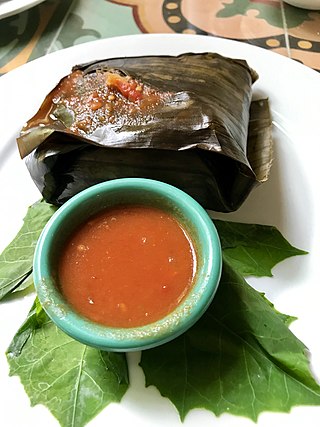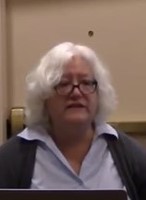Third gender is a concept in which individuals are categorized, either by themselves or by society, as neither a man or woman. It is also a social category present in societies that recognize three or more genders. The term third is usually understood to mean "other", though some anthropologists and sociologists have described fourth and fifth genders.

Lubaantun is a pre-Columbian ruined city of the Maya civilization in southern Belize, Central America. Lubaantun is in Belize's Toledo District, about 42 kilometres (26 mi) northwest of Punta Gorda, and approximately 3.2 kilometres (2 mi) from the village of San Pedro Columbia, at an elevation of 61 metres (200 ft) feet above mean sea level. One of the most distinguishing features of Lubaantun is the large collection of miniature ceramic objects found on site; these detailed constructs are thought to have been charmstones or ritual-accompanying accoutrements.
Gender roles existed in Mesoamerica, with a sexual division of labour meaning that women took on many domestic tasks including child-rearing and food preparation while only men were typically allowed to use weapons and assume positions of leadership. Both men and women farmed, but in some societies, women were not permitted to plough the fields because it was believed to symbolise men's role in the reproductive cycle.

The history of chocolate dates back over 5,000 years. The cacao tree is native to the tropics of the Americas. The cocoa bean was first domesticated at least 5,300 years ago in what is present-day southeast Ecuador by the Mayo-Chinchipe culture, before being introduced in Mesoamerica. Originally prepared as a drink, chocolate was served as a bitter liquid, mixed with spices or corn puree. In Mesoamerica, it was believed to be an aphrodisiac and to give the drinker strength. Today, such drinks are also known as "Chilate" and are made by locals in the south of Mexico and the north triangle of Central America. After its arrival to Europe in the sixteenth century, sugar was added to it and it became popular throughout society, first among the ruling classes and then among the common people. In the 20th century, chocolate was considered essential in the rations of United States soldiers during war.

Trade in Maya civilization was a crucial factor in maintaining Maya cities.

Ancient Maya cuisine was varied and extensive. Many different types of resources were consumed, including maritime, flora, and faunal material, and food was obtained or produced through strategies such as hunting, foraging, and large-scale agricultural production. Plant domestication concentrated upon several core foods, the most important of which was maize.
Maya textiles (k’apak) are the clothing and other textile arts of the Maya peoples, indigenous peoples of the Yucatán Peninsula in Mexico, Guatemala, Honduras, El Salvador and Belize. Women have traditionally created textiles in Maya society, and textiles were a significant form of ancient Maya art and religious beliefs. They were considered a prestige good that would distinguish the commoners from the elite. According to Brumfiel, some of the earliest weaving found in Mesoamerica can date back to around 1000-800 B.C.E.
Ancient Maya women had an important role in society: beyond propagating the culture through bearing and raising children, Maya women participated in economic, governmental, and farming activities. The lives of women in ancient Mesoamerica are not well documented: "Of the three elite founding area tombs discovered to date within the Copan Acropolis, two contain the remains of women, and yet there is not a single reference to a woman in either known contemporary texts or later retrospective accounts of Early Classic events and personages at Copan," writes a scholar.

Talgua Cave is a cave located in the Olancho Valley in the municipality of Catacamas in northeastern Honduras. The misnomer “The Cave of the Glowing Skulls” was given to the cave because of the way that light reflects off of the calcite deposits found on the skeletal remains found there. The site has gained the interest of archaeologists studying cave burials of Central America and of Mesoamerica as one of the most extensive Early to Middle Pre-Classic ossuary cave sites currently known to have been in contact with the Maya societies of nearby Mesoamerica. It provides many valuable clues to how the inhabitants of the Talgua Cave may have been an important link between Pre-Columbian Mesoamerica and parts further south and east in Central America and extending into those societies in northern South America, a region known as the Isthmo-Colombian Area.

Mokaya were pre-Olmec cultures of the Soconusco region in Mexico and parts of the Pacific coast of western Guatemala, an archaeological culture that developed a number of Mesoamerica’s earliest-known sedentary settlements.

Pozol is the name of both fermented corn dough and the cocoa drink made from it, which has its origins in Pre-Columbian Mesoamerica. The drink is consumed in the south of Mexico in the states of Campeche, Chiapas, and Tabasco. It is a thirst quencher that has also been used to fight diseases. It has also aided indigenous peoples of the Americas as sustenance on long trips across the jungles.
David Michael Pendergast, is an American Archaeologist, and is most famous for his work at Altun Ha and Lamanai, Belize. He received a Bachelor of Arts in Anthropology in 1955 from the University of California, Berkeley, and earned his Ph.D. in 1961 at the University of California, Los Angeles, studying with Clement Meighan. He was later married to Elizabeth Graham, also a Mesoamerican Archaeologist.
Wendy Ann Ashmore was an American professor of Maya archaeology at the University of California, Riverside. She was involved in excavations in Belize, Guatemala, and Honduras. Her research focused on the implications that spaces, settlement patterns, and gender can have on social organization. She received her B.A. from the University of California, Los Angeles in 1970 and her Ph.D. in 1981 from the University of Pennsylvania. Her dissertation analyzed the results of the site periphery program that took place between 1975 and 1979 at Quirigua, Guatemala. In her dissertation, she discusses the use of random sampling in the Maya region and offers suggestions for how research might be carried out in that region in the future. In the 1980s she taught archaeology at Rutgers University. She left for a position at the University of Pennsylvania. Ashmore died in 2019 at her home in Riverside, California.

Patrick Edward McGovern is the scientific director of the Biomolecular Archaeology Laboratory for Cuisine, Fermented Beverages, and Health at the University of Pennsylvania Museum in Philadelphia, where he is also an adjunct professor of anthropology. In the popular imagination, he is known as the "Indiana Jones of Ancient Ales, Wines, and Extreme Beverages"

Playa de los Muertos is an archaeological site from the Middle Formative period and is located on the Honduras north coast, in the Ulua valley, however it has "had a continuous history going back as early as any sedentary society yet documented in Mesoamerica". Thought to at one time have been a village, Playa de los Muertos is primarily known through its burials and ceramics. Archaeologists have identified a strong Aztec and Mayan influence on the early inhabitants at Playa de los Muertos, however it is considered a distinct culture. The site is most notable for its finely made ceramic figurines, famously excavated by Dorothy Popenoe. These figurines, in particular those depicting the female form, have helped archaeologists interpret gender roles at the site. Archaeologists believe that people at Playa de los Muertos likely participated in long-distance trade networks which reach from Guatemala to the Gulf Coast Olmec centers.

The extensive trade networks of the Ancient Maya contributed largely to the success of their civilization spanning three millennia. Maya royal control and the wide distribution of foreign and domestic commodities for both population sustenance and social affluence are hallmarks of the Maya visible throughout much of the iconography found in the archaeological record. In particular, moderately long-distance trade of foreign commodities from the Caribbean and Gulf Coasts provided the larger inland Maya cities with the resources they needed to sustain settled population levels in the several thousands. Though the ruling class essentially controlled the trade economy, a middle merchant class supervised import and export from cities and trade ports. Not much is known of the Maya merchant class; however, merchants of royal lineage are sometimes represented in the iconography. Notably, a canoe paddle often accompanies the royal merchant depictions, signifying their association with marine resources.
Economy is conventionally defined as a function for production and distribution of goods and services by multiple agents within a society and/or geographical place An economy is hierarchical, made up of individuals that aggregate to make larger organizations such as governments and gives value to goods and services. The Maya economy had no universal form of trade exchange other than resources and services that could be provided among groups such as cacao beans and copper bells. Though there is limited archeological evidence to study the trade of perishable goods, it is noteworthy to explore the trade networks of artifacts and other luxury items that were likely transported together.
Aztec body modification was practiced by the members of the Aztec Empire in Mesoamerica. Many times the body modification was used in ritual or ceremonial practices. It was also a crucial part of movement between major life stages.
The Middle American Research Institute was established at Tulane University in 1924.
Lynn Meskell is an Australian archaeologist and anthropologist who currently works as a Professor at the University of Pennsylvania.









